How to Fix Windows Black Screen of Death
If you’ve ever experienced a black screen of death on your Windows computer, you know how frustrating it can be. The black screen appears suddenly and it can be quite difficult to determine what caused it. In this article, we will provide you with some solutions to fix the Windows black screen of death issue.

What is the Black Screen of Death?
The black screen of death is a common issue on Windows computers. It is similar to the blue screen of death, but instead of a blue screen, the computer displays a black screen. The black screen may appear after you boot your computer or while you are using it. It can occur due to various reasons such as a hardware issue, a software problem, or a driver issue.
Common Causes of Windows Black Screen of Death
There are many different causes of the black screen of death. Some of the most common causes are:
1. Hardware issues
Hardware issues such as a faulty graphics card or a damaged monitor can cause the black screen of death.
2. Driver issues
Outdated or corrupted drivers can cause the black screen of death. This can occur when you update Windows or install new hardware.
3. Software problems
A software problem such as a corrupted system file or a virus can cause the black screen of death.
How to Fix the Windows Black Screen of Death
Now that you know some of the common causes of the black screen of death, let’s look at some solutions to fix it.
1. Check the Hardware
The first thing you should do is check the hardware. Make sure that all cables are connected properly and that there are no loose connections. If you have a spare monitor, try connecting it to your computer to see if the issue is with your monitor.
2. Boot into Safe Mode
If your computer boots into safe mode, it means that the issue is with a driver or a software problem. To boot into safe mode, follow these steps:
- Turn on your computer and continuously press the F8 key until you see the Advanced Boot Options screen.
- Use the arrow keys to select “Safe Mode with Networking” and press enter.
3. Update Drivers
If the issue is with a driver, you can update it by following these steps:
- Press the Windows key + X and select “Device Manager.”
- Locate the device with the driver issue and right-click on it.
- Select “Update Driver Software” and follow the on-screen instructions.
4. Run a System Restore
If the issue is with a software problem, you can try running a system restore. This will restore your computer to a previous state where it was working correctly. To run a system restore, follow these steps:
- Press the Windows key + R to open the Run dialog box.
- Type “rstrui.exe” and press enter.
- Follow the on-screen instructions to restore your computer to a previous state.
5. Run a Virus Scan
If the issue is with a virus, you can try running a virus scan. This will scan your computer for any viruses and remove them. To run a virus scan, follow these steps:
- Install an antivirus software on your computer.
- Open the antivirus software and run a full system scan.
Conclusion
The black screen of death on Windows can be a troublesome issue. However, with the solutions provided in this article, you should be able to fix the issue and get your computer back up and running. Remember to always keep your drivers and software up to date, and run regular virus scans to prevent such issues from occurring in the future.












